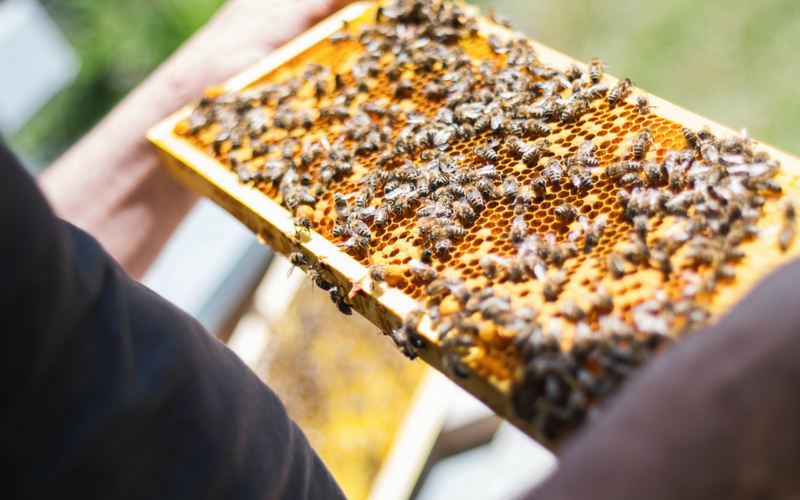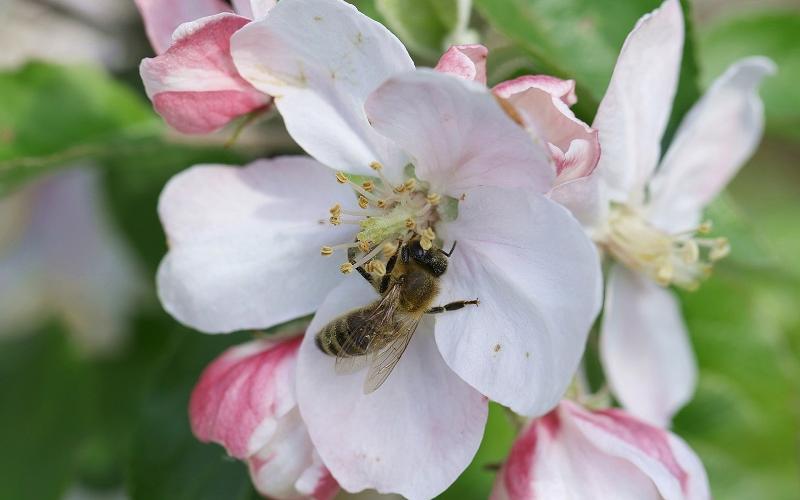Winter has come to the world as it is known to the hardworking honey bee. “Game of Thrones,” the popular HBO series based on George R. R. Martin’s bestselling books, set in a harsh world, its characters struggling as they face hard truths, might be a fitting metaphor for what is happening in the kingdom of the honey bee. But this is no game.
The European honey bee, Apis mellifera, is the most economically valuable pollinator of agricultural crops worldwide. Bee pollination is responsible for more than $15 billion in added crop value in the United States. Especially dependent on bees are specialty crops such as almonds and other nuts, berries, fruits and vegetables. And there is the product of the bees themselves: honey.

“Sadly, when all of this started to happen back around 2005–2006 with the bees just disappearing from their hives, nobody knew what to call it, so the media latched onto something called CCD, or colony collapse disorder, and that’s just a misnomer,” said Michele Colopy, program director at the Pollinator Stewardship Council in Akron, Ohio. “It is not explaining the issue well enough, and we would like the media to stop using it.”
In fairness to the media, the term originated in the mid-2000s with the U.S. Department of Agriculture (USDA), where scientists were scrambling for an explanation. But the origins of the term hardly matters.
Beekeepers had awakened to a nightmare of sickened, even vacant, hives.
Think of their anxiety this way, suggested Colopy: “Honey bees are a beekeeper’s livestock, and they suffer under the same health stresses as any four-legged livestock that doesn’t have wings.”
What happened? As Colopy stressed, in recent years, it has become clear that no single factor is responsible. According to the USDA, research is beginning to strongly suggest that CCD “may be a syndrome caused by many different factors, working in combination or synergistically.”
As in the mythical “Game of Thrones,” the very real forces arrayed against the kingdom of the honey bee, the hive, have converged to lay siege in many guises and from many directions.
Some likely candidates have recently been identified. There remains speculation about additional culprits.
What we know about “colony collapse disorder”
According to the USDA, researchers have documented elevated pathogen levels, and a wide array of pesticides have been present in the wax and pollen in both CCD-affected and non-affected apiaries, with none linked definitively to CCD.
Pesticides
“The wax (inside the hive) holds onto pesticides,” said Colopy. “It is a sponge. So, when a pesticide is brought into the hive on pollen or nectar or on the bodies of the bees, the toxin in the pesticide stays active for a longer time because it’s in the dark — most pesticides break down in sunlight.

“But it’s not that we can suddenly open the hive to sunlight to change this, because the wax still holds onto the toxin and protects it,” she continued. “The toxin leaches through the wax.”
Beginning in 2015, beekeepers began to report more bee deaths in late summer than in winter. It was a troubling sign. Hives are expected to be stronger and healthier in warm weather and more stressed in the cold months.
“What is happening at the end of summer is the full effect of the pesticides,” explained Colopy. “They build up across the summer, and the bees are eating these toxins. This slowly kills off the adult foragers. Then the whole organism of the hive is thrown off because different bees have different duties, based on their age.
“If you suddenly have too many foragers dying and everybody gets shoved ahead in their duties, you start to throw off the life cycle of the hive,” she continued. “The queen’s reproduction ability declines; there aren’t enough bees to help raise the brood, so you begin to slowly lose the population, and this is where that so-called ‘colony collapse’ comes in.”
Mites
In addition to pesticides, infestations of mites have taken a toll.
Varroa destructor, a parasitic mite, propagates within the brood cells of bees. The mites can do serious damage to their hosts' health, latching on and feeding on hemolymph, insects' rough equivalent to blood. Bees are left with open wounds, making them susceptible to infection.
Adding insult to injury, noted Kentucky State apiarist Tammy Potter, is a finding that Varroa mites can introduce viruses — one, in particular — to honey bee colonies.
“Lake Sinai virus, named for a lake in South Dakota, is fairly new,” she said. “It has characteristics that look remarkably similar to what we used to call colony collapse disorder.
“Forty-six percent of our (Kentucky) apiaries have high Varroa mite counts,” continued Potter, referencing the most recent USDA Honey Bee Health Survey. “There was only one from this particular year that did not have a virus present. The other 23 did.”
Researchers and the USDA have urged a change in management strategy, including more frequent sampling.
“Given the biology of the Varroa mite, the best management practice is to sample your bees for mites four times a year,” said Potter.
In 2015, the EPA approved the use of oxalic acid (OA) as a Varroa mite treatment. Various studies have shown OA to be effective in a variety of climatic conditions with an efficacy as high as 97 percent in a broodless period.
But it’s far too soon to breathe easy. Researchers at Purdue University have discovered that a sister species of the Varroa destructor mite is “shifting from feeding and reproducing on Asian honey bees, their preferred host, to European honey bees, the primary species used for crop pollination and honey production worldwide.”
While Varroa Jacobsoni mites have not been found outside of Papua New Guinea, Purdue researcher Gladys Andino said vigilance is needed to protect European honey bees worldwide from further risk.
"This could represent a real threat,” said Andino. “If this mite gets out of control and spreads, we might have another situation like V. destructor."
The Purdue researchers note with caution that “V. destructor made the same host leap at least 60 years ago, spreading rapidly to become the most important global health threat to European honey bees.”
The Honey Bee Health Coalition, an organization of beekeepers, researchers, government agencies, agribusinesses, growers, conservation groups, manufacturers and consumer brands, is holding its first Mite-A-Thon in September. The event is “a national effort to collect mite infestation data and to visualize Varroa infestations in honey bee colonies across North America within a one-week window.” The Varroa monitoring data will be uploaded to www.mitecheck.com.
Continuing research also focuses on additional possible CCD factors, such as the synergistic effects of the Nosema fungus and pesticides, and of pesticides and other pathogens.
Monocultures
Even before CCD came along, one of the biggest challenges for native wild bees has been the agricultural specialization that has produced huge fields of just one crop: the monoculture.
The almond groves of California, for example, are a sea of blossoms in February.
"But for the rest of the year, there's nothing blooming," Claire Kremen, a conservation biologist at the University of California, Berkeley told NPR. "In fact, in places where we have very large monocultures of almond, we don't find any native bees anymore."
So honey bees must be trucked in from all over the country. And the industry's migratory characteristic may also contribute to the colony collapse problem.
“If you start in South Dakota and you take your bees to California, where there are also honey bees from Indiana, Kentucky and Texas, that virus can be spread,” said Potter.
Time is money, and this travel leaves little time to sample for mites, which can be a lengthy process. However, necessity has inspired invention, said Potter.
“There is a new tool on the market to help beekeepers quickly sample their bees,” she said. “I think you will begin to see a significant decrease in hive mortality.”
The Varro Easy Check tool uses an alcohol solution to remove mites from up to 300 bees at a time.
Forage land development
Working in combination with the impact of monocultures is the development of countryside and forests. Much pollinator habitat has been lost to urban and suburban development as well as surface mining.
“Many pollinators are adversely affected when large, intact tracts of habitat are broken up into smaller, isolated patches by road construction, development or agriculture,” observed a joint study by the Center for Biodiversity and Conservation at the American Museum of Natural History and the Greenbelt Native Plant Center. “These habitat fragments may not be large enough to meet all pollinator needs by themselves.”
Honey bees are left without the diverse sources of nectar and pollen they need to thrive when confronted with multiple factors known to affect their survival, growth and reproduction, the study concluded.
How can we help the bees?
What can be done to improve survival prospects for these industrious, socially sophisticated creatures and the human agriculture that depends on them?
A survey of its beekeeper members by the Honey Bee Health Coalition found a demand for companies to offer supplemental pollen patties that address “specific regional, seasonal, and/or life cycle challenges and objectives.”
They identified two primary drivers for beekeepers to feed protein supplements: “to stimulate colonies to produce more brood at certain times of year; and to offer nourishment when natural pollen flow is lacking.”
Initial trials of the Alltech supplement Bee Pollen-Ate® suggest a promising response.

“We’re increasing brood during low pollen levels,” said Kyle McKinney, Alltech’s crop science manager in Costa Rica. “It means the whole hive is active and healthy. When the queen lays the brood, the worker bees come in and start feeding the brood and building up the comb to protect the brood. We know with certainty that what we’ve seen in Costa Rica, during low pollen season, supplementing with Bee Pollen-Ate, we have a healthier and more active hive.”
Acting as something of a worksite food truck, the quarter-inch-thick patty is placed atop the comb where the bees are working.

“They come up and they feed on the patty and go back to work,” explained McKinney.
There are numerous feed supplements on the market, and many beekeepers make their own “patty” of supplements.
“I see about a 50-50 split between people who want to make their own patty using their own recipe versus people who want to buy a finished patty,” noted McKinney. “But even those who make their own are using our Bee Pollen-Ate as the protein supplement.”
McKinney’s research partner, Tyler Bramble, general manager of Alltech ruminant nutrition in Visalia, California, said it appears that many commercial companies making pollen substitute products are in a race to see who can pack the most protein into a bee supplement patty.
“I’m not convinced that more is always better,” he said. “I think you really need to look at the form and the digestibility. We see in livestock animals deleterious effects as protein levels become ridiculous. It costs the animal energy to process and get rid of all that extra protein.”
The distinction between the Alltech product and others, Bramble noted, is the particular expertise behind its development.
“With Alltech’s core competencies being animal nutrition and yeast fermentation, we understand all the different parts of a yeast cell,” he said. “That’s our business. We fractionate the yeast cell, and, because of our knowledge of the yeast cell and its various components, we are able to pull out protein, carbohydrate and nucleotide-rich portions of the cell. That enables us to make a designer pollen substitute.”
With McKinney in Costa Rica, where it is now winter, and Bramble in California, where summer is in full force, the two are teaming up to carry out continuous trials of Bee Pollen-Ate. Their findings are anticipated by spring of 2018.
A “what if” to ponder
But what if all of our best efforts fail to restore the honey bee population to levels required for crop pollination? One possibility makes the long, deadly winter of “Game of Thrones” seem springlike by comparison.
There is the prospect that in the not-too-distant future, farmers might not have to rely on declining bee populations. For example, researchers at Tokushima University in Japan have used the CRISPR gene-editing technique to produce seedless tomatoes, which do not require pollination at all.

























